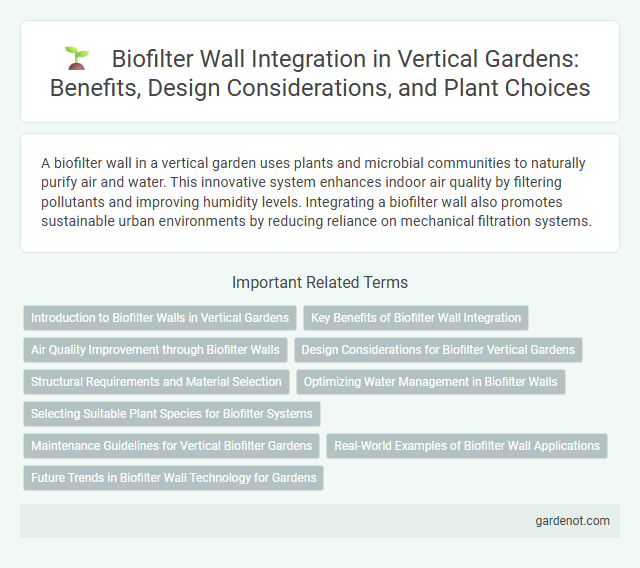A biofilter wall in a vertical garden uses plants and microbial communities to naturally purify air and water. This innovative system enhances indoor air quality by filtering pollutants and improving humidity levels. Integrating a biofilter wall also promotes sustainable urban environments by reducing reliance on mechanical filtration systems.
Introduction to Biofilter Walls in Vertical Gardens
Biofilter walls in vertical gardens act as natural air purifiers by leveraging plants and substrate to filter pollutants and improve indoor air quality. These living walls use a combination of microbial activity and plant root systems to break down volatile organic compounds (VOCs) and airborne toxins. Incorporating biofilter walls enhances urban environments by promoting sustainability and wellness through biophilic design.
Key Benefits of Biofilter Wall Integration
A biofilter wall significantly improves air quality by naturally removing pollutants and toxins through plant-root filtration systems. This integration enhances urban biodiversity by providing habitats for beneficial microorganisms and insects, promoting ecosystem health. Energy efficiency is boosted as the biofilter wall acts as natural insulation, reducing heating and cooling costs in buildings.
Air Quality Improvement through Biofilter Walls
Biofilter walls in vertical gardens utilize plants and microorganisms to naturally filter pollutants, significantly enhancing indoor and outdoor air quality. This sustainable technology reduces airborne contaminants such as volatile organic compounds (VOCs) and particulate matter, promoting healthier environments in urban spaces. Incorporating biofilter walls supports carbon dioxide absorption and oxygen release, contributing to climate regulation and improved respiratory health.
Design Considerations for Biofilter Vertical Gardens
Design considerations for biofilter vertical gardens include selecting appropriate plant species with high pollutant absorption capabilities and root structures optimized for filtration. Structural integrity and water-retention systems must ensure even moisture distribution and adequate support for the biofilter media. Integrating efficient airflow pathways enhances contaminant removal, making maintenance accessibility essential to sustain biofilter performance and plant health.
Structural Requirements and Material Selection
Biofilter walls in vertical gardens require a robust structural framework capable of supporting the weight of plants, water, and filtration media, often using galvanized steel or treated timber for durability and corrosion resistance. Material selection prioritizes lightweight, water-resistant substrates such as coconut coir or felt mats to facilitate root growth and efficient microbial activity for pollutant removal. Proper drainage systems integrated into the biofilter wall design ensure optimal water flow and prevent structural damage from moisture accumulation.
Optimizing Water Management in Biofilter Walls
Biofilter walls optimize water management by utilizing advanced irrigation systems that recycle and filter water to maintain humidity and support plant health. Integrating porous substrates and hydrophilic materials enhances water retention and distribution, reducing runoff and minimizing waste. These biofilter systems also improve air quality by naturally filtering pollutants through the roots and microbial activity in the substrate.
Selecting Suitable Plant Species for Biofilter Systems
Selecting suitable plant species for biofilter walls is critical to maximizing air purification and pollutant absorption. Species with high transpiration rates and robust root systems, such as spider plants, ferns, and peace lilies, efficiently trap airborne toxins while promoting microbial activity within biofilter substrates. Optimal plant selection enhances biofilter system performance by improving air quality and supporting sustainable vertical garden ecosystems.
Maintenance Guidelines for Vertical Biofilter Gardens
Vertical biofilter gardens require regular maintenance to ensure optimal air purification and plant health. Monitoring moisture levels and preventing root rot by adjusting irrigation schedules is essential for sustained biofilter efficiency. Periodic trimming of plants and inspection for pests or nutrient deficiencies help maintain the structural integrity and performance of the biofilter wall.
Real-World Examples of Biofilter Wall Applications
Biofilter walls have been effectively implemented in urban environments to improve air quality by filtering pollutants through plants and substrate layers. Notable examples include the Oasia Hotel in Singapore, which utilizes a biofilter facade to reduce carbon dioxide levels and enhance biodiversity. Another application is the CaixaForum Museum in Madrid, where the vertical garden acts as a natural air purifier and thermal insulator, demonstrating sustainable design in densely populated areas.
Future Trends in Biofilter Wall Technology for Gardens
Biofilter wall technology in vertical gardens is evolving with advancements in smart sensors that optimize air purification and water usage, enhancing environmental sustainability. Integration of IoT devices allows real-time monitoring of plant health and pollution levels, promoting efficient maintenance and improved ecosystem balance. Emerging materials such as biodegradable substrates and nano-coatings increase filtration capacity and durability, setting new standards for eco-friendly urban landscaping.
Biofilter wall Infographic

 gardenot.com
gardenot.com